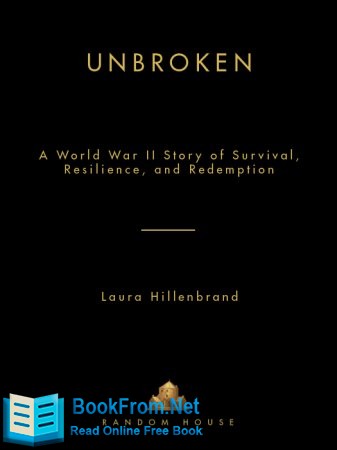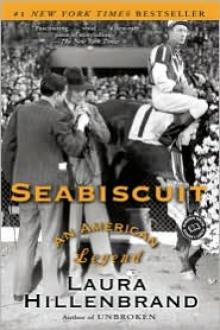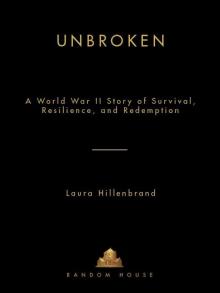- Home
- Laura Hillenbrand
Unbroken Page 33
Unbroken Read online
Page 33
5 Louie had eaten in restaurants only twice: Louis Zamperini, Olympic diary; Louis Zamperini, telephone interview.
6 Food on the Manhattan: Louis Zamperini, interview by George Hodak, Hollywood, Calif., June 1988, AAFLA; Archie F. Williams, interviewed by George A. Hodak, Santa Rosa, Calif., June 1988, AAFLA.
7 “Of course, most of this was due,” Louie sitting with Jack Torrance: Dr. James LuValle, interview by George Hodak, Palo Alto, Calif., June 1988, AAFLA.
8 Dinner list: Jack Coleman, letter to Louis Zamperini, list and commentary written on back.
9 Weight gain: Kenneth Griffin, interview by George Hodak, Carlsbad, Calif., August 1988, AAFLA; Louis Zamperini, Olympic diary; “First Light Workouts,” article in Zamperini scrapbook, July 23, 1936, NPN; Malcolm W. Metcalf, interviewed by George A. Hodak, Claremont, Calif., February 1988, AAFLA.
10 Athletes stealing glasses: Joanna de Tuscan Harding, interviewed by George A. Hodak, Hollywood Hills, Calif., April 1988, AAFLA.
11 “Wo ist Jesse?”: Dr. James LuValle, interview by George Hodak, Palo Alto, Calif., June 1988, AAFLA.
12 Olympic Village: Arvo Vercamer and Jason Pipes, “The 1936 Olympic Games in Germany,” www.feldgrau.com (accessed July 19, 2006); Richard Mandell, The Nazi Olympics (Urbana: University of Illinois Press, 1987), pp. 88–92, 138; Louis Zamperini, interview by George Hodak, Hollywood, Calif., June 1988, AAFLA.
13 Japanese feeding deer: “Sports Parade,” Los Angeles Examiner, July 30, 1936.
14 Storks: Arvo Vercamer and Jason Pipes, “The 1936 Olympic Games in Germany,” www.feldgrau.com (accessed July 19, 2006).
15 Owens pursued by fans: Dr. James LuValle, interview by George Hodak, Palo Alto, Calif., June 1988, AAFLA.
16 Drive through Berlin: Mandell, pp. 139–43; Herbert H. Wildman, interviewed by George A. Hodak, Marina del Rey, Calif., October 1987, AAFLA.
17 Gliders: Iris Cummings Critchell, telephone interview, September 29, 2005.
18 Gypsies: “The Facade of Hospitality,” U.S. Holocaust Museum, www.ushm.org/museum/exhibit/online/olympics/zcd062.htm (accessed June 16, 2005).
19 Doves: Louis Zamperini, telephone interview; Iris Cummings Critchell, telephone interview, September 29, 2005; Mandell, p. 145.
20 Bulging eyes, Louie versus Finns: “Sport Shorts,” undated article in Zamperini scrapbook, NPN.
21 German nationalism: Iris Cummings Critchell, telephone interview, September 29, 2005; Iris Cummings Critchell, interviewed by George A. Hodak, Claremont, Calif., May 1988, AAFLA.
22 “Don’t let them see me!”: Iris Cummings Critchell, telephone interview, September 29, 2005.
23 Qualifying round: “Owens in New Record,” Los Angeles Evening Herald and Express, August 4, 1936; “Zamperini Is In,” Torrance Herald, August 6, 1936.
24 “tired as hell”: Louis Zamperini, Olympic diary, August 4, 1936, entry.
25 Olympic final: Louis Zamperini, telephone interview; “Finn Star Wins 5,000 Meter Title,” Waterloo Daily Courier, August 7, 1936; “Archie Williams Wins 400 Meter Title,” Galveston Daily News, August 8, 1936; “Sweep in Sprints,” Emporia Gazette, August 7, 1936; “First American,” undated article from Zamperini scrapbook, NPN; “Three Americans,” undated article in Zamperini scrapbook, NPN; “Brown Skies,” Los Angeles Times, August 8, 1936; “Sports Parade,” Los Angeles Times, August 14, 1936; Stuart Cameron, “Finland Wins Clean Sweep in Distance Running by Taking 5000-Meter Finals,” Dunkirk (N.Y.) Evening Observer, August 7, 1936; “Olympic Games Results,” Reno Evening Gazette, August 7, 1936; “Archie Williams Wins 400 Meter Final,” Chester (Pa.) Times, August 7, 1936; “Williams Victory Gives U.S. Olympic Dash Sweep,” Syracuse (N.Y.) Herald, August 7, 1936; “Dusky Archie: United States Athletes Take One, Two, Three Lead in Olympics Decathlon,” San Antonio Express, August 8, 1936.
26 Hitler contorting himself: “Cunningham,” Los Angeles Times, August 8, 1936.
27 Final laps in distance races: Bill Henry, “Bill Henry Says,” Los Angeles Times, undated; Mandell, p. 40.
28 Meeting Hitler: Louis Zamperini, telephone interview; Louis Zamperini, interview by George Hodak, Hollywood, Calif., June 1988, AAFLA.
29 Flag: “Zamperini Stormed Hitler’s Palace—Lived!,” undated article from Zamperini papers, NPN; “Bombardier Zamperini Seeks Return Trip to Germany,” article from Zamperini papers, August 13, 1942, NPN; “Zamp Will Try Again,” article from Zamperini papers, August 13, 1942, NPN; Louis Zamperini, telephone interviews; Louis Zamperini, interview by George Hodak, Hollywood, Calif., June 1988, AAFLA.
30 Lubin sees anti-Semitism: Frank J. Lubin, interviewed by George A. Hodak, Glendale, Calif., May 1988, AAFLA.
31 Anti-Semitic signs, Der Stürmer: “The Facade of Hospitality,” U.S. Holocaust Museum, www.ushm.org/museum/exhibit/online/olympics/detail.php?content-facade_hospitality_more&lang=en (accessed April 29, 2010).
32 Fürstner kills himself: Mandell, p. 92.
33 Sachsenhausen: “The Facade of Hospitality,” U.S. Holocaust Museum, www.ushm.org/museum/exhibit/online/olympics/detail.php?content=facade_hospitality_more&lang=en (accessed April 29, 2010).
34 Homecoming: “Zamperini Home,” Torrance Herald, September 3, 1936; “Invalid Woman,” Torrance Herald, undated article from Zamperini scrapbook; “Olympic Games Hero,” Torrance Herald, September 3, 1936; “Runner Tells,” Torrance Herald, September 3, 1936; “Cheering Mass,” Torrance Herald, September 4, 1936; Louis Zamperini, telephone interview; Louis Zamperini, interview by George Hodak, Hollywood, Calif., June 1988, AAFLA.
35 “I didn’t only”: “Cheering Mass,” Torrance Herald, September 4, 1936.
36 Plans for 1940: “Runner Tells,” Torrance Herald, September 3, 1936; Louis Zamperini, telephone interview; Peter Zamperini, telephone interviews, October 15, 17, 19, 22, 2004.
37 Tokyo given 1940 Games: “Tokyo Prepares,” article from Zamperini scrapbook, August 1, 1936, NPN.
Chapter 5: Into War
1 Payton Jordan: Payton Jordan, telephone interviews, August 13, 16, 2004.
2 High jumper on her bed: Sylvia Flammer, telephone interviews, October 25, 27, 2004.
3 Pranks: Louis Zamperini, telephone interview.
4 Sasaki: Louis Zamperini, telephone interview; Payton Jordan, telephone interviews, August 13, 16, 2004; Bruce Gamble, Black Sheep One: The Life of Gregory “Pappy” Boyington (Novato, Calif.: Presidio, 2000), p. 323; the following Kunichi Sasaki and James Kunichi Sasaki records from RG 331, RAOOH, WWII, 1907–1966, SCAP, Legal Section, Administration Division and Prosecution Division, NACP: Kunichi Sasaki, Isamu Sato, Kazuo Akane, 1945–1948, Investigation and Interrogation Reports; Nakakichi Asoma et al., trial, exhibits, appeal, and clemency files; Nakakichi Asoma et al., 1945–1952, POW 201 File, 1945–1952, Charges and Specifications, 1945–1948.
5 Sasaki’s true college record: Harvard, Yale, Princeton, USC registrar archives; inquiries with Degreecheck.com, April 2007.
6 Louie’s winning: George Davis, “Fresno Relays Are Next,” undated article in Zamperini scrapbook, NPN; “Zamperini Stars,” Los Angeles Examiner, May 8, 1938; “Zamperini, Day Smash Meet Marks,” undated 1938 article in Zamperini scrapbook, NPN.
7 Coach predicts world record: Lee Bastajian, “Trojans Meet Stanford,” undated spring 1938 article from Zamperini scrapbook, NPN.
8 Seabiscuit only runner to beat him: Louis Zamperini, telephone interview.
9 Cunningham prediction: George Davis, “Cunningham Predicts Zamperini Next Mile Champ,” undated 1938 article from Zamperini scrapbook, NPN.
10 Fastest mile projected to be 4:01.6: Brutus Hamilton, Amateur Athlete, February 1935.
11 Louie training on stairs: Louis Zamperini, telephone interview; Louis Zamperini, interview by George Hodak, Hollywood, Calif., June 1988, AAFLA.
12 First four-minute man: Charlie Paddock, “Sportorials,” undated April 1938 article from Zamperini scrapbook, NPN; George Davis, “For Sake of Sport,” Los Angeles Evening Herald and Express, undated 1938 articl
e from Zamperini scrapbook; George Davis, “Cunningham Predicts Zamperini Next Mile Champ,” undated article from Zamperini scrapbook, NPN; “History of the Record for the Mile Run,” InfoPlease, www.infoplease.com (accessed July 9, 2004); Paul Scheffels, “4 Minute Mile Run Is Closer,” Modesto (Calif.) Bee, February 14, 1940.
13 Prerace warning: Louis Zamperini, telephone interview; Payton Jordan, telephone interviews, August 13, 16, 2004; Louis Zamperini, interview by George Hodak, Hollywood, Calif., June 1988, AAFLA.
14 1938 NCAA Championship race: Louis Zamperini, telephone interview; Payton Jordan, telephone interviews, August 13, 16, 2004; “Zamperini’s Record Mile Beats Fenske,” Minnesota Journal, June 18, 1938; Charles Johnson, “Zamperini Sets Mark,” Star Nighthawk, June 18, 1938; “Mile Record Smashed at Collegiate Meet,” Minneapolis Tribune, June 18, 1938; Louis Zamperini, interview by George Hodak, Hollywood, Calif., June 1988, AAFLA.
15 Crowd gasps, Woooo!: Payton Jordan, telephone interviews, August 13, 16, 2004.
16 Japan drops Olympics, Finland takes over: Relman Morin, “Japan Abandons Olympics Plans,” Appleton (Wisc.) Post-Crescent, July 14, 1938; “Finland Okays Olympic Games,” Lowell (Mass.) Sun, July 19, 1938.
17 Louie’s indoor races: “Fenske Outruns Zamperini by Three Yards,” Fresno Bee, February 18, 1940; “Fenske Again Beats Best U.S. Milers,” Oakland Tribune, February 18, 1940; “Fenske’s Brilliant Millrose Victory Stamps Him ‘King of Milers,’ ” Nebraska State Journal (Lincoln), February 5, 1940; Paul Scheffels, “4 Minute Mile Run Is Closer,” Modesto (Calif.) Bee, February 14, 1940.
18 Indoor versus outdoor records: Jon Hendershott, associate editor, Track and Field News, email interview, May 6, 2009; Wally Donovan, A History of Indoor Track and Field (El Cajon, Calif.: Edward Jules Co., 1976), p. 294; “History of the Record for the Mile Run,” InfoPlease, www.infoplease.com (accessed July 9, 2004).
19 Japan’s economic plight, ambitions, preparations: David James, The Rise and Fall of the Japanese Empire (London: George Allen and Unwin, 1951), pp. 6–17, 119–27, 168, 173; Iris Chang, The Rape of Nanking: The Forgotten Holocaust of World War II (London: Penguin Books, 1998), pp. 25–38.
20 “There are superior”: John W. Dower, War Without Mercy: Race and Power in the Pacific War (New York: Pantheon Books, 1993), p. 217.
21 “plant the blood”: Ibid., p. 277.
22 Military-run schools, soldier training: Chang, pp. 29–32, 57; James Bradley, Flyboys (New York: Little, Brown, 2003), pp. 34–36.
23 “Imbuing violence”: Chang, p. 218.
24 Stadium partially collapsed: Lon Jones, “War Cheats Trojans: Olympic Chances Lost,” Los Angeles Examiner, February 28, 1940.
25 Lehtinen gives medal: “Lauri Lehtinen,” All Experts, https://en.allexperts.com/e/l/la/lauri_lehtinen.htm (accessed September 11, 2009).
26 Bright, Cunningham enlist: Kiell, pp. 320–21; Georgie Bright Kunkel, “My Brother Was a Long Distance Runner,” West Seattle Herald, August 21, 2008.
27 Jittery and airsick: Louis Zamperini, letter to Virginia Zamperini, April 10, 1941; Louis Zamperini, telephone interview.
28 Candy bars: Louis Zamperini, telephone interview.
29 Informant’s report: Letters between J. Edgar Hoover and Brigadier General Sherman Miles, October–November 1941, FBI, acquired from Department of the Army, United States Army Intelligence and Security Command, Freedom of Information/Privacy Office, Fort George G. Meade, Md.
30 Notes from police officer: Notes by Captain Ernie Ashton, Torrance police detective, written alongside a passage on Sasaki in Ashton’s copy of Zamperini’s 1956 autobiography, Devil at My Heels, from papers of Louis Zamperini.
31 Sasaki in Washington: The following Kunichi Sasaki and James Kunichi Sasaki records from RG 331, RAOOH, WWII, 1907–1966, SCAP, Legal Section, Administration Division and Prosecution Division, NACP: Kunichi Sasaki, Isamu Sato, Kazuo Akane, 1945–1948, Investigation and Interrogation Reports; Nakakichi Asoma et al., trial, exhibits, appeal, and clemency files; Nakakichi Asoma et al., 1945–1952, POW 201 File, 1945–1952, Charges and Specifications, 1945–1948.
32 Hoover orders probe: Letters between J. Edgar Hoover and Brigadier General Sherman Miles, October–November 1941, Federal Bureau of Investigation, acquired from Department of the Army, United States Army Intelligence and Security Command, Freedom of Information/Privacy Office, Fort George G. Meade, Md.
33 Pilot over Hawaii: Mitsuo Fuchida and Masatake Okumiya, Midway: The Battle That Doomed Japan (Bluejack Books, 2001).
34 Activities on Oahu: William Cleveland, ed., Grey Geese Calling (Askov: American Publishing, 1981), p. 203; Stetson Conn, Rose Engelman, and Byron Fairchild, United States Army in World War II: Guarding the United States and Its Outposts (Washington, D.C.: Center of Military History, U.S. Army, 1964), p. 191; Clive Howard and Joe Whitley, One Damned Island After Another: The Saga of the Seventh (Chapel Hill: University of North Carolina Press, 1946), p. 25; Robert Cressman and J. Michael Wenger, “Infamous Day,” Marines in WWII Commemorative Series, https://www.nps.gov/archive/wapa/indepth/extContent/usmc/
pcn-190-003116-00/sec3.htm (accessed September 10, 2009).
35 Two planes lost: “Timeline Pearl Harbor,” Pearl Harbor Remembered, https://my.execpc.com/~dschaaf/mainmenu.html (accessed April 29, 2010).
36 Man killed during pillow fight, friend sees Japanese plane crash: Cleveland, p. 203.
37 Louie, Pete learn of Pearl Harbor: Louis Zamperini, telephone interview; Peter Zamperini, telephone interview, October 19, 2004.
PART II
Chapter 6: The Flying Coffin
1 Pancakes: Ken Marvin, telephone interview, January 31, 2005.
2 “Calm!”: William Manchester, The Glory and the Dream: A Narrative History of America, 1932–1972 (New York: Bantam Books, 1974), p. 258.
3 Eleanor Roosevelt writes Anna: Doris Kearns Goodwin, No Ordinary Time: Franklin and Eleanor Roosevelt—the Home Front in World War II (New York: Simon and Schuster, 1994), p. 289.
4 Butler overheard president: Ibid., p. 290.
5 Japanese staffers burning documents: “Japanese Embassy Burns Official Papers,” Wisconsin State Journal (Madison), December 8, 1941; Manchester, p. 258.
6 Days after December 7: Carl Nolte, “Pearl Harbor Was a Close Thing for the City in 1941,” San Francisco Chronicle, December 7, 2006; Stanley Pillsbury, telephone interview, August 25, 2004; “Entire City Put on War Footing,” NYT, December 8, 1941; “U.S. Cities Prove They Can Swing into Action,” Wisconsin State Journal (Madison), December 8, 1941; Adam Fjell, “ ‘A Day That Will Live in Infamy’: Buffalo County and the Attack on Pearl Harbor,” Buffalo Tales, November–December 2002, vol. 25, no. 6; Goodwin, pp. 295–96.
7 Wake’s defense: Lieutenant Colonel R. D. Heinl, Jr., USMC, The Defense of Wake, Marines in World War II: Historical Monograph (Historical Section, Division of Public Information Headquarters, U.S. Marine Corps, 1947).
8 Men on Wake singing: Ken Marvin, telephone interview, January 31, 2005.
9 Louie’s test scores: Certificate of Proficiency, Air Force Preflight School (bombardier, navigator), Ellington Field, from papers of Louis Zamperini.
10 Norden bombsight: William Darron, Army Air Forces Historical Association, Oradell, N.J., interview and bombsight demonstration, courtesy of Robert Grenz, 2004; Louis Zamperini, telephone interview; “Bombardiers’ Information File,” War Department, Army Air Forces, March 1945.
11 Twice the price of a house: “The Year 1942,” The People History, https://www.thepeoplehistory.com/1942.html (accessed September 11, 2009); “The Norden M-1 Bomb Sight,” Plane Crazy, https://www.plane-crazy.net/links/nord.htm (accessed September 11, 2009).
12 Ephrata: Sam Britt, Jr., The Long Rangers, A Diary of the 307th Bombardment Group (Baton Rouge: Reprint Company, 1990), pp. 4–5.
13 Phillips: Karen Loomis, telephone interview, November 17, 2004; Monroe Bormann, telephone interview, June 7, 2005; Phoebe Bormann, telephone interview, June 7, 2005; Louis Zamper
ini, telephone interview; Jesse Stay, telephone interviews, July 23, 2004, and March 16, 2005; Kelsey Phillips, “A Life Story,” unpublished memoir.
14 Sandblaster: Jesse Stay, telephone interviews, July 23, 2004, and March 16, 2005.
15 Cecy Perry: Karen Loomis, telephone interview, November 17, 2004; Monroe Bormann, telephone interview, June 7, 2005; Phoebe Bormann, telephone interview, June 7, 2005; letters from Russell Phillips to Cecy Perry, 1941–43.
16 Cecy’s ring: Russell Allen Phillips, letters to Cecy Perry, March 11, 21, 1942.
17 “I’ve wished 100 times”: Russell Allen Phillips, letter to Cecy Phillips, summer 1942.
18 Phil’s bomber crew: Stanley Pillsbury, telephone interviews, August 25, 2004, March 9, 2005, and August 18, 2006; Charles McMurtry, “Liberator, Hit 594 Times, Wings Home Safely,” Richmond News Leader, May 14, 1943.
19 Harry Brooks’s fiancée: “Sergt. H. V. Brooks Served in Pacific,” undated article from Phillips scrapbook, NPN.
20 B-24s: Charlie Tilghman, B-24 pilot, Commemorative Air Force, telephone interview, February 14, 2007; Consolidated Aircraft, Flight Manual: B-24D Airplane (1942), Flight Manual for B-24 Liberator, Aircraft Manual Series (Appleton, Wisc.: Aviation Publications, 1977); Martin Bowman, Combat Legend: B-24 Liberator (Shrewsbury, Eng.: Airlife, 2003); Frederick A. Johnsen, B-24 Liberator, Rugged but Right (New York: McGraw-Hill, 1999); Fiske Hanley II, telephone interview, July 30, 2004; Byron Kinney, email interview, April 26, 2007.
21 “it was like sitting”: Byron Kinney, email interview, April 26, 2007.
22 Left arms stronger: Stephen E. Ambrose, The Wild Blue: The Men and Boys Who Flew the B-24s over Germany (New York: Simon and Schuster, 2001), p. 77.
23 Tails falling off: Johnsen, p. 28.
24 “It’s the Flying Coffin”: Louis Zamperini, telephone interview.
25 Training: Stanley Pillsbury, telephone interviews, August 25, 2004, March 9, 2005, and August 18, 2006.
26 “I grew a little”: Russell Allen Phillips, letter to Cecy Perry, August or September 1942.
27 “I guess you read”: E. C. Williams, letter to Louis Zamperini, July 1, 1941.
28 Stateside crash statistics: Army Air Forces Statistical Digest, World War II, Office of Statistical Control, December 1945, Tables 213 and 214.
29 Deaths of friends: Russell Allen Phillips, letter to Cecy Perry, October 1942.
30 Phil runs from meeting to write home: Russell Allen Phillips, letter to Cecy Perry, October 7, 1942.
31 Training for crashes: Louis Zamperini, telephone interview; Consolidated Vultee Aircraft Corporation, Service Department, Emergency Procedure: B-24 Airplane (San Diego: Consolidated Vultee Aircraft Corporation, 1944), pp. 21–25.
32 “kind of silly”: Russell Allen Phillips, television interview, CBS, La Porte, Ind., January 1997.
33 “a damn swell pilot”: “Son of Pickett ‘Sky Pilot’ Pilots Bomber Over Wake I,” undated article from Phillips scrapbook, NPN.
34 Phil’s B-24: Stanley Pillsbury, telephone interviews, August 25, 2004, March 9, 2005, and August 18, 2006; Louis Zamperini, telephone interview; Russell Allen Phillips, television interview, CBS, La Porte, Ind., January 1997.
35 Phil’s dream of Cecy: Russell Allen Phillips, letter to Cecy Perry, August 15, 1942.
36 Phil misses Cecy by three days: Russell Allen Phillips, letter to Cecy Perry, November 2, 1942.
37 B-24 names: “Warpaint Photo Album,” Something About Everything Military, https://www.jcs-group.com/military/war1941aaf/warpaint1.html (accessed September 26, 2009).
38 Moznette names plane: Russell Allen Phillips, letter to Kelsey Phillips, February 13, 1943.
39 Phil says plane masculine: Russell Allen Phillips, letter to Cecy Perry, March 25, 1943.
40 Japan’s empire: West Point Atlas for the Second World War, Asia and the Pacific, map 22.
Chapter 7: “This Is It, Boys”
1 Oahu in 1942: Stanley Pillsbury, telephone interviews, August 25, 2004, March 9, 2005, and August 18, 2006; Cleveland, p. 158.
2 “one sees only about ⅓”: Cleveland, p. 158.
3 Barracks: Jesse Stay, “Twenty-nine Months in the Pacific,” unpublished memoir.
4 “You kill one”: Russell Allen Phillips, letter to Kelsey Phillips, December 8, 1942.
5 “like a dozen dirty”: Russell Allen Phillips, letter to Cecy Perry, April 2, 1943.

 Unbroken
Unbroken Seabiscuit: An American Legend
Seabiscuit: An American Legend Unbroken: A World War II Story of Survival, Resilience, and Redemption
Unbroken: A World War II Story of Survival, Resilience, and Redemption